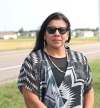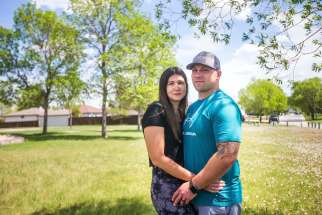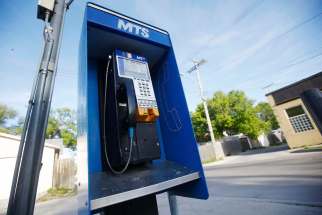Outcry over residential school grave echoes of Canada’s broken promises
Read this article for free:
or
Already have an account? Log in here »
To continue reading, please subscribe:
Monthly Digital Subscription
$0 for the first 4 weeks*
- Enjoy unlimited reading on winnipegfreepress.com
- Read the E-Edition, our digital replica newspaper
- Access News Break, our award-winning app
- Play interactive puzzles
*No charge for 4 weeks then price increases to the regular rate of $19.00 plus GST every four weeks. Offer available to new and qualified returning subscribers only. Cancel any time.
Monthly Digital Subscription
$4.75/week*
- Enjoy unlimited reading on winnipegfreepress.com
- Read the E-Edition, our digital replica newspaper
- Access News Break, our award-winning app
- Play interactive puzzles
*Billed as $19 plus GST every four weeks. Cancel any time.
To continue reading, please subscribe:
Add Free Press access to your Brandon Sun subscription for only an additional
$1 for the first 4 weeks*
*Your next subscription payment will increase by $1.00 and you will be charged $16.99 plus GST for four weeks. After four weeks, your payment will increase to $23.99 plus GST every four weeks.
Read unlimited articles for free today:
or
Already have an account? Log in here »
Hey there, time traveller!
This article was published 01/06/2021 (1654 days ago), so information in it may no longer be current.
Chief Henry Prince had a question for treaty commissioners during the final days of Treaty 1 negotiations in Manitoba.
The chief of the St. Peters band wanted to know about the future of Indigenous children if First Nations signed a pact with the Crown.
“How are we to be treated?” asked Prince, the day before he and other chiefs signed the first treaty between First Nations and the new Dominion of Canada in 1871 at Lower Fort Garry.
“The land cannot speak for itself, we have to speak for it and want to know fully how you are going to treat our children.”
It was, perhaps, a more important question than Prince could have imagined.
The federal government would pass the Indian Act five years later — the main instrument used to rip Indigenous children from their homes and place them in residential schools, sometimes never to be seen again by their families.
Adams Archibald, Manitoba’s first lieutenant governor and the Queen’s representative at Treaty 1 talks, assured Prince government would treat First Nations on equal footing with “whites.”“The land cannot speak for itself, we have to speak for it and want to know fully how you are going to treat our children.” — Henry Prince, St. Peters band chief, in 1871
In addition to setting aside reserve lands, providing them with annuities and farm implements, Ottawa would give First Nations a school and a schoolmaster for each reserve.
Nobody said anything about a residential school system, especially ones designed to beat Indigenous culture, language and identity out of First Nations children; nor about subjecting them to physical and sexual abuse and forcing them to live in unsafe, unsanitary conditions away from their homes.
There was no mention during treaty talks at the “Stone Fort” (just north of Winnipeg) that if an Indigenous child died while attending a residential school, they would be buried unceremoniously nearby.
Sadly, that is how Canadian history unfolded.
It was not just a “dark chapter” of Canada’s past, as it’s often described. In all its ugliness, inhumanity and naked racism, it is the story of our country, which has endured into modern-day Canada.
The discovery last week of an unmarked grave near a former residential school in Kamloops, B.C., where 215 Indigenous children were buried, has struck a chord with Canadians.
It is not the first known burial site used by residential schools. At least 4,117 Indigenous children (likely far more) are known to have died while attending the institutions, which were run more like jails than schools.
Many — if not most — were buried in such graves, often without the knowledge of their families, the 2015 Truth and Reconciliation Commission of Canada found.
As awareness grows around the atrocities facing Indigenous people, news of the unmarked grave is piercing the consciousness of Canadians in a way not seen before.Among the great tragedies of this story, children’s names were not even recorded in almost two-thirds of the deaths.
It’s serving as a wake-up call, perhaps a more poignant one than in years past, about the wretched impacts of colonial rule. There is a true feeling of national mourning.
TRC research found residential school children died at between two to five times the rate of children in the general population, from 1921 and 1950 (there was little comparative data prior to that).
They died mostly of tuberculosis and other diseases. There were also suicides, accidental deaths and other causes not documented. Among the great tragedies of this story, children’s names were not even recorded in almost two-thirds of the deaths.
The main reason residential schools buried deceased students in nearby graves was to save money, records show. It was cheaper than to transport the bodies to home communities.
“It is not the practice of the department to send bodies of Indians by rail excepting under very exceptional circumstances,” the Department of Indian Affairs wrote in a 1938 letter to a grieving Indigenous mother, who requested the body of her son.
This was not the future promised to Indigenous leaders 150 years ago at the Stone Fort.
This is not the future Henry Prince envisioned when he asked how Indigenous children would be treated under the new Dominion of Canada.
But it’s the Canada we have all inherited.
tom.brodbeck@freepress.mb.ca

Tom has been covering Manitoba politics since the early 1990s and joined the Winnipeg Free Press news team in 2019.
Our newsroom depends on a growing audience of readers to power our journalism. If you are not a paid reader, please consider becoming a subscriber.
Our newsroom depends on its audience of readers to power our journalism. Thank you for your support.






.jpg?h=215)



